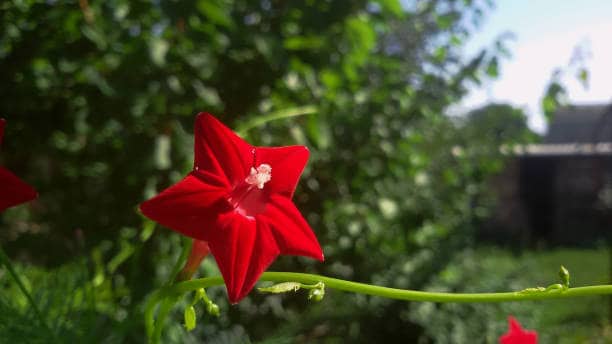Cardinal Climber, also known as Cypress Vine or Hummingbird Vine are fast-growing and vigorous tender vines. It typically grows up to 15 feet tall in one season, making it a suitable choice for covering up walls that need additional adornment. On their branches and foliage, it produces bright green, fern-like foliage. Furthermore, Cardinal Climbers bloom from summer to fall, forming tubular star-shaped flowers that measure one inch wide. Their bright scarlet color and rich nectar attracts butterflies and hummingbirds from far and wide.
Cardinal Climber is a species in the Ipomoeaceae family and is classified as a perennial. The name Ipomoea quamoclit originated from the Greek words “ipos” and “haima” meaning “worm” and “blood” respectively, referring to the typical shades of red that these flowers can take. The alternate old common name “Wild Balsam” is derived from the Latin family name for the species, BALSAMINACEAE.
How to plant
Cardinal Climbers can thrive both indoors and outdoors depending on the climate. They require full sun with moist, well-drained soil, which should be kept consistently damp for proper development. Additionally, these vines need something to hold onto, like an arbor or a trellis, for them to grow and spread. They don’t need a lot of fertilizer, but it’s recommended that you should add some to keep the soil moist.
Meaning and symbolism
Cardinal Climbers are known as a symbol of faith, endurance, love, and longevity. It is also seen as an indication of passionate love, strong friendship, and an outpouring of emotion. These flowers also have healing and protective properties, which adds to its religious and symbolic significance. Their bright red hue also adds to its symbolic status, as it is a sign of a prosperous and successful future.
History, mythology, and religious significance
Cardinal Climbers have been used as decorations and offerings in religious ceremonies, celebrations, and festivals for many centuries. It was also an important part of ancient Greek medicine, used to treat respiratory illnesses, carcinoma, and certain skin decaying diseases. In Greek mythology, it was linked to Aphrodite and as such was believed to possess special powers. In Christianity, it was seen as a representation of divine love, suffering, and sympathy.
Flower varieties and their defining characteristics
Ipomoea quamoclit is native to Mexico, South America, and the Caribbean and is found growing wild in various regions of the United States. There are several varieties of this species, each of which has its own distinct characteristics. Some of the common varieties of Cardinal Climber include, but are not limited to, morning glory, pink glory, moon pearls, blue star, Victorian star, and sweet potato vine.
Morning glory is a classic and hardy variety of Ipomoea quamoclit, with huge white petals dotted with dark purple and burgundy strips, and dark green foliage to contrast. Pink Glory is a beautiful and colorful version of morning glory, with pink and white petals and bright green foliage. Moon pearls has white petals that open after sunset, adding a mysterious element to the area. Blue star is a striking variety with large blue flowers, while the Victorian star is a more elegant choice with its lavender petals. Sweet potato vine, on the other hand, is a hardy perennial with vining foliage and small, white flowers.
How to pot and repot
Cardinal Climbers can be easily potted and repotted by following a few simple steps. To begin planting, find a container that is wide and shallow, with drainage holes in the bottom, and fill it with potting soil. When planting, ensure that the base of the plant is even with the top of the soil and pack lightly. After the vine has been planted, water it thoroughly and allow it to drain any excess water. Place the potted plant in a sunny area and wait for the plant to become established before you repot it. When repotting, transfer the soil and the plant to a bigger or differently shaped container, if needed, and water it lightly.
How to prune
Cardinal Climbers generally require minimal pruning, but it is still important to do it correctly. If the vine starts to overcrowd its environment, or if you want to encourage growth in certain directions, you can trim the vine. You should wait until the vine has fully established itself and has started to flower before you decide to prune it. When trimming the vine, use sharp cutting tools and angled cuts to ensure a clean cut. Cut only excessive growth and avoid removing more than half of the vine, as this can hamper the growth and blooming of the plant.
How to propagate
You can propagate Cardinal Climbers through stem cuttings or through division. When propagating by stem cuttings, select healthy and viable stems and remove them from the mother plant. Prepare small plastic pots filled with moistened potting mix and create a large enough hole for the stem to be placed in. The stem should be placed in the hole with at least two nodes buried beneath the soil. Firmly pack the soil around it and spray it with water. For division, use a sharp knife to divide the clumps of established vines. Choose a healthy shoot and cut through the root ball, making sure to keep the root structure intact. Replant the shoot in a new pot or area, and water them accordingly.
Common pests and diseases
Cardinal Climbers typically do not suffer from significant pests or disease problems. However, they can be susceptible to certain fungal and bacterial diseases, such as leaf spot, root rot, and powdery mildew. To avoid such problems, it is important to ensure that the soil is moist and well-drained and to keep the area free of any standing water. Additionally, it is important to check for pests, such as aphids and whiteflies, which may cause leaf damage. If either is found, it is best to treat the affected area with the appropriate pesticide.
Frequently Asked Questions
Question 1: Can Cardinal Climber be planted indoors?
Answer 1: Yes, Cardinal Climbers can be planted indoors in humid, well-lit environments. However, they require consistent care and maintenance to prevent them from becoming overcrowded or infested with pests.
Question 2: How long do Cardinal Climbers take to grow?
Answer 2: Cardinal Climbers typically take around one year to reach their full mature size of 15 feet tall. However, in the first season, they may only reach a height of 3-4 feet.
Question 3: When do Cardinal Climbers flower?
Answer 3: Cardinal Climbers bloom from summer to fall. Their bright scarlet blooms attract butterflies and hummingbirds far and wide.
Table Fact Sheet
| Cardinal Climber | Ipomoea quamoclit |
|---|---|
| Family | Ipomoeaceae |
| Plant Type | Perennial |
| Mature Size | Up to 15 feet |
| Sun Exposure | Full sun |
| Soil Type | Moist, well-drained |
| Soil pH | 6 to 7.5 |
| Bloom Time | Summer to fall |
| Flower Color | Scarlet |
| Hardiness Zones | 4 to 9 |
| Native Area | Mexico, South America, and the Caribbean |
What we love from Amazon this week
Buy these wonderful flowers directly from Amazon:















